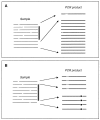A high frequency of sequence alterations is due to formalin fixation of archival specimens
- PMID: 10550302
- PMCID: PMC1866966
- DOI: 10.1016/S0002-9440(10)65461-2
A high frequency of sequence alterations is due to formalin fixation of archival specimens
Abstract
Genomic analysis of archival tissues fixed in formalin is of fundamental importance in biomedical research, and numerous studies have used such material. Although the possibility of polymerase chain reaction (PCR)-introduced artifacts is known, the use of direct sequencing has been thought to overcome such problems. Here we report the results from a controlled study, performed in parallel on frozen and formalin-fixed material, where a high frequency of nonreproducible sequence alterations was detected with the use of formalin-fixed tissues. Defined numbers of well-characterized tumor cells were amplified and analyzed by direct DNA sequencing. No nonreproducible sequence alterations were found in frozen tissues. In formalin-fixed material up to one mutation artifact per 500 bases was recorded. The chance of such artificial mutations in formalin-fixed material was inversely correlated with the number of cells used in the PCR-the fewer cells, the more artifacts. A total of 28 artificial mutations were recorded, of which 27 were C-T or G-A transitions. Through confirmational sequencing of independent amplification products artifacts can be distinguished from true mutations. However, because this problem was not acknowledged earlier, the presence of artifacts may have profoundly influenced previously reported mutations in formalin-fixed material, including those inserted into mutation databases.
Figures


Comment in
-
Literature on BRCA1 mutations not cited.Am J Pathol. 2000 Apr;156(4):1478. doi: 10.1016/S0002-9440(10)65017-1. Am J Pathol. 2000. PMID: 10753122 Free PMC article. No abstract available.
References
-
- Ben-Ezra J, Johnson DA, Rossi J, Cook N, Wu AJ: Effect of fixation on the amplification of nucleic acids from paraffin-embedded material by the polymerase chain reaction. J Histochem Cytochem 1991, 39:351-354 - PubMed
-
- Pontén F, Williams C, Ling G, Ahmadian A, Nistér M, Lundeberg J, Pontén J, Uhlén M: Genomic analysis of single cells from human basal cell cancer using laser-assisted capture microscopy. Mutat Res 1997, 382:45-55 - PubMed
-
- Eckert KA, Kunkel TA: DNA polymerase fidelity and the polymerase chain reaction. PCR Methods Appl 1991, 1:17-24 - PubMed
-
- Hultman T, Bergh S, Moks T, Uhlén M: Bidirectional solid-phase sequencing of in vitro-amplified plasmid DNA. Biotechniques 1991, 10:84-93 - PubMed
Publication types
MeSH terms
Substances
LinkOut - more resources
Full Text Sources
Other Literature Sources
Miscellaneous

